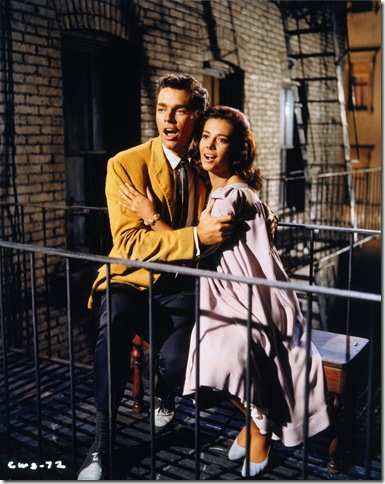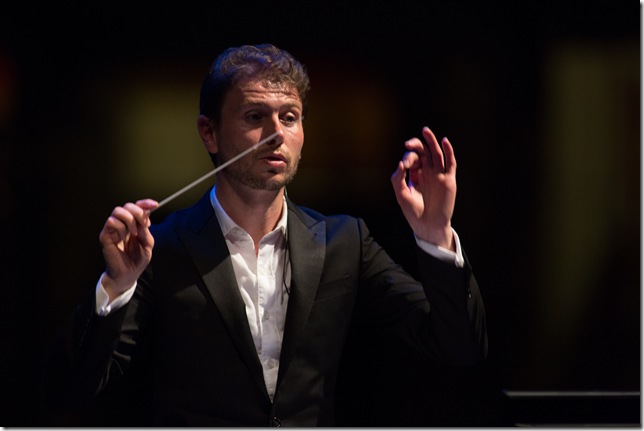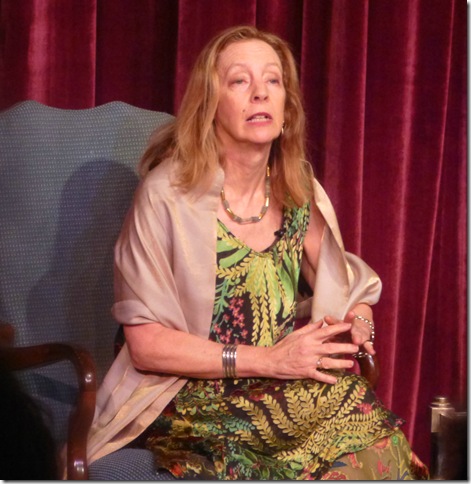By Dale King
At the halfway point of the 2015 Festival of the Arts Boca, many audiences have already seen and heard a great deal about Leonard Bernstein. His elder daughter, Jamie Bernstein, kicked off the annual 10-day event March 4 with a lecture about her father’s legacy, offering backstories about the making of perhaps his most famous work, the musical and film versions of West Side Story.
Two nights later, a nearly standing room-only crowd in the Mizner Park Amphitheater watched a newly mastered version of the film on a panoramic screen. The original music had been wiped clean from the soundtrack, leaving only the dialogue and vocals.
The Festival Orchestra Boca, under the apt and very specific direction of Jayce Ogren, put back the songs in elegant, rhythmic style, timed perfectly to the film. Ovations were many, and as the end credits rolled, the audience redoubled their applause every time Bernstein’s name came on the screen.
A final burst of Bernstein music will be heard Saturday night when the Young People’s Chorus of New York City performs a West Side Story medley during its performance at the Amphitheater, starting at 7:30.
The 1961 movie recounts an era when teenage street gangs roamed the Upper West Side of New York City in the 1950s. Two rival gangs, the Jets (Caucasians) and the Sharks (Puerto Ricans) squabble over their respective turfs at a time when a new phrase, “juvenile delinquents,” had just entered the American lexicon.
Songs by Leonard Bernstein (with lyrics by then-newcomer Stephen Sondheim) include “Something’s Coming,” “Maria,” “America,” “Somewhere,” “Tonight,” “Jet Song,” “I Feel Pretty,” “A Boy Like That,” “One Hand, One Heart,” “Gee, Officer Krupke” and “Cool.”
The story is loosely based on William Shakespeare’s Romeo and Juliet. Tony (Richard Beymer), a former leader of the Jets, falls in love with Maria (Natalie Wood), the sister of Sharks member Bernardo (George Chakiris). Like the Bard’s star-crossed lovers, the romance between Tony and Maria cannot endure, because they are from two different groups, two different families. Their passion grows at the same time the rancor between the Sharks and Jets approaches fever pitch. The music, with its thumping, often frenetic backbeat fronted at times by loud brass, also gets stronger.
The atmosphere seems to intensify with sound like an ever-louder beating heart as the action builds. Then, the music drifts off as a quieter, tear-stained conclusion spreads over the warring gangs, allowing Tony and Maria one last heart-wrenching embrace in the silence of stunned onlookers.
“I have a brother and sister, Alexander and Nina, and we are all working to keep our father’s legacy alive — which is a good thing,” Jamie Bernstein told a rapt audience at the Cultural Arts Center two nights before the film presentation. She began creating Bernstein-related musical programs in the early 1990s, working with Michael Barrett, a Leonard Bernstein protégé who served as the maestro’s assistant conductor from 1985 to 1990 and is currently music adviser to the Leonard Bernstein estate.
The first show, The Bernstein Beat, met with success worldwide, Jamie Bernstein said. So did Bernstein on Broadway, a compilation of Leonard Bernstein tunes in a show led by four singers.
Jamie Bernstein, responding to audience demand, talked at length about her father, his foibles and his association with West Side Story. “He was a bundle of contradictions,” she said. “He was extroverted, he loved noisy dinners and Jewish jokes and all-night talk sessions. Yet, sometimes he was an introvert, working long hours alone on his music.”
A chain-smoking bundle of energy, he died in 1990 at age 72. “We were surprised he lasted that long.”
Leonard Bernstein was “classically trained, but he loved pop music. [Longtime Boston Symphony Orchestra conductor Serge] Koussevitzky told him to change his name to Leonard S. Burns.” He didn’t do it.
Jamie said her father’s Broadway tunes were “elegantly constructed.” He made an effort to combine high-brow and low-brow tunes, coming up with an odd combo she called “Bernstein’s no-brow.”
A lover of anagrams, Bernstein employed that same methodical approach in his music. Jamie said he created “tri-tone notes in endless anagrams.” One way was to take a succession of three major-key notes, push up the middle note slightly until it was neither minor nor major. “That was his ambiguity,” she said. “It can be heard in the first three notes of ‘Ma-ri-a,’” she said. “It was very cool.”
She gave a glimpse of her father’s ardor when she read letters exchanged by her parents during the run-up to West Side Story in summer 1957 when she and her mother, Felicia Montealegre, visited Montealegre’s native Chile during the South American winter. The letters revealed Bernstein’s tremendous fear about the success of his work, the night-and-day toil on the piece and his enduring desire to make it happen.
It did. The musical premiered on Broadway on Sept. 26, 1957. The film would follow in four years. It was nominated for 11 Academy Awards and won 10, including Best Supporting Actor (Chakiris), Best Supporting Actress (Rita Moreno) and Best Picture.


